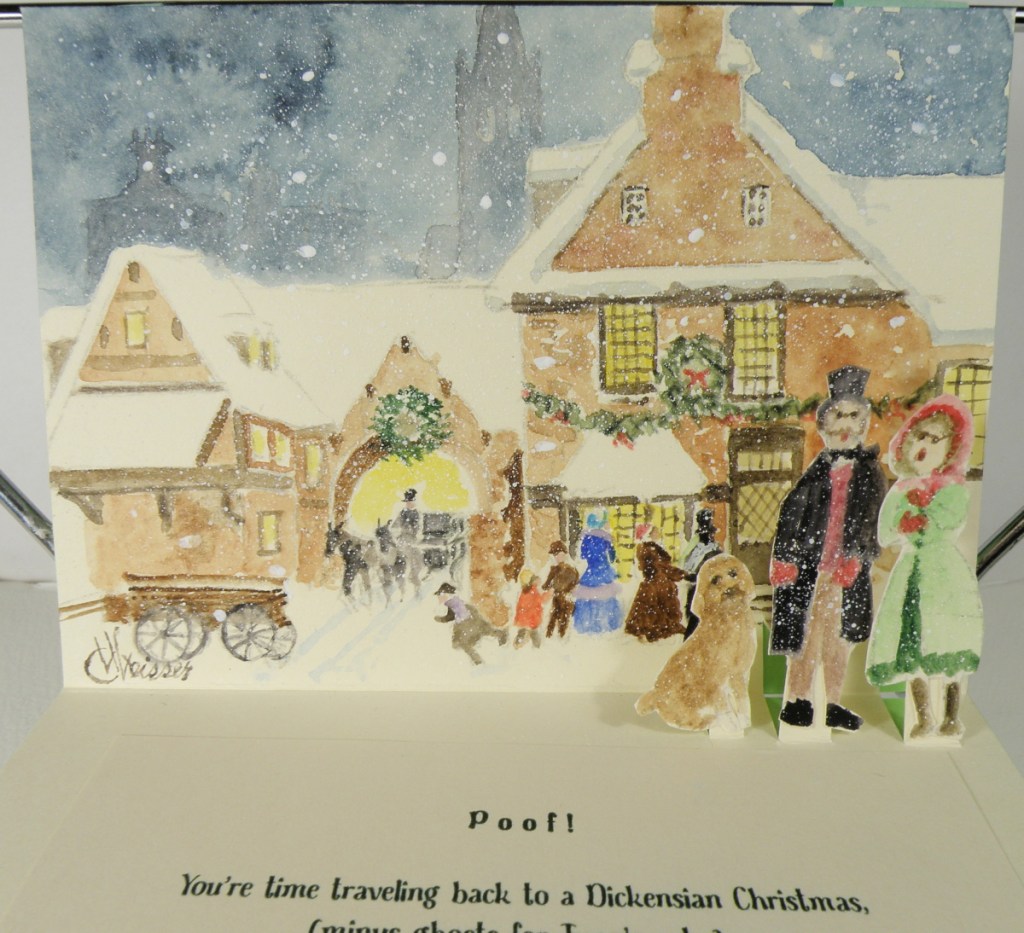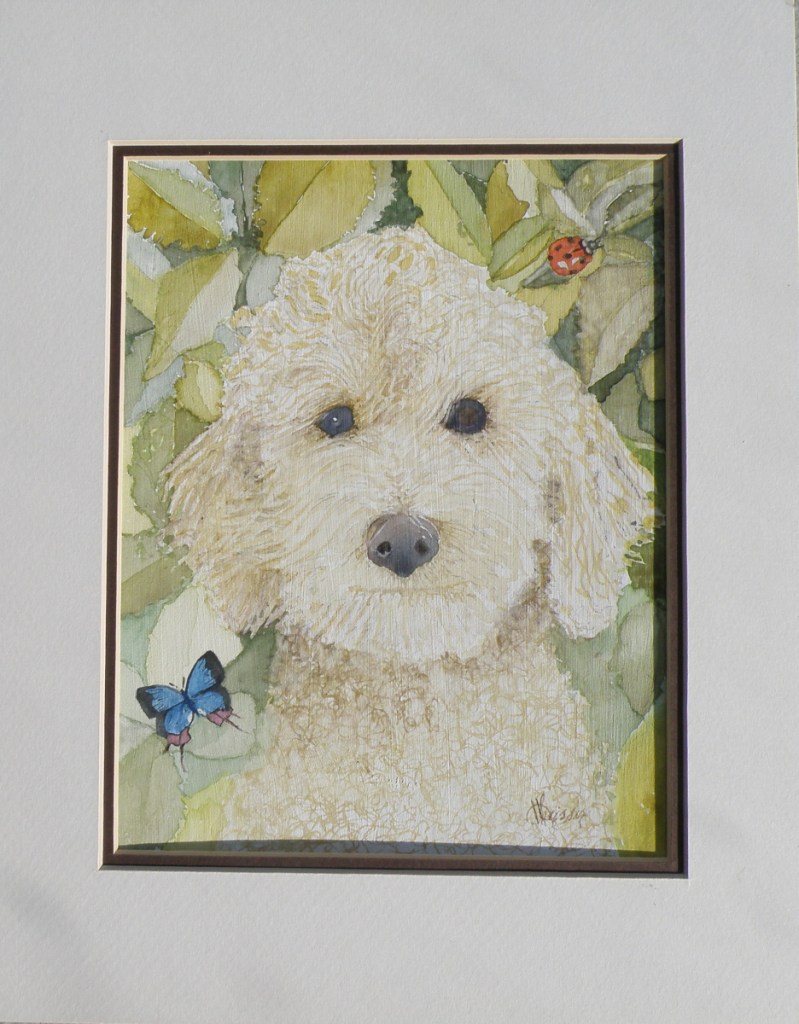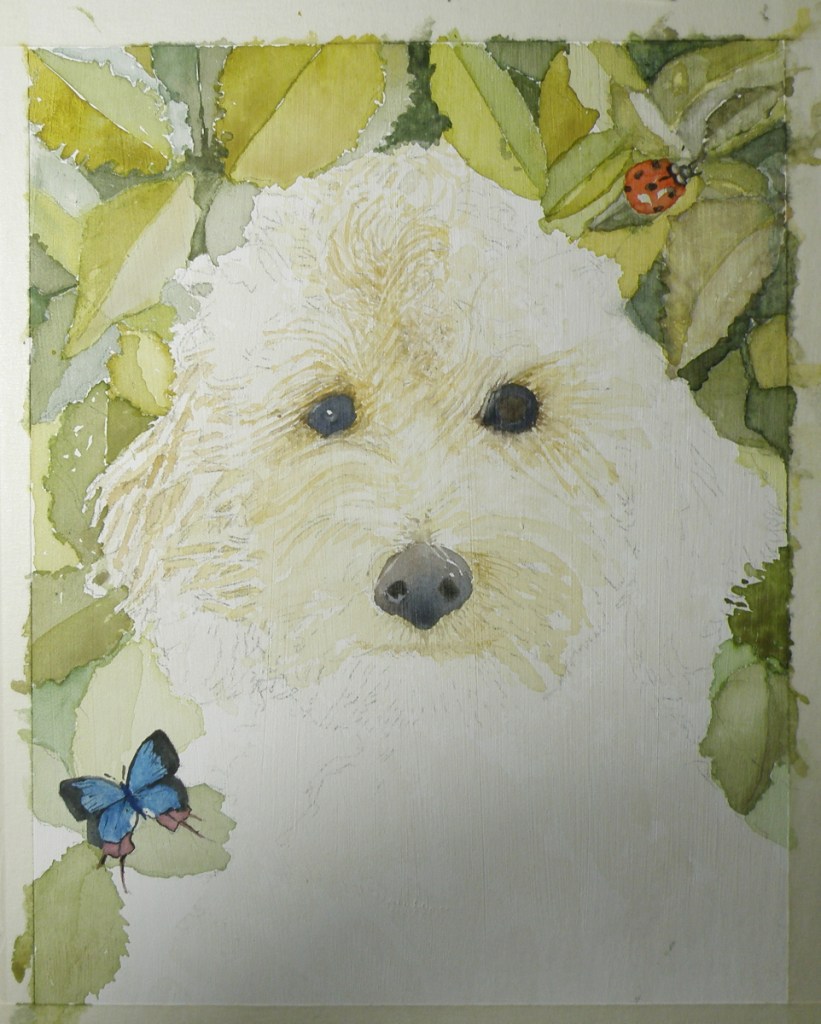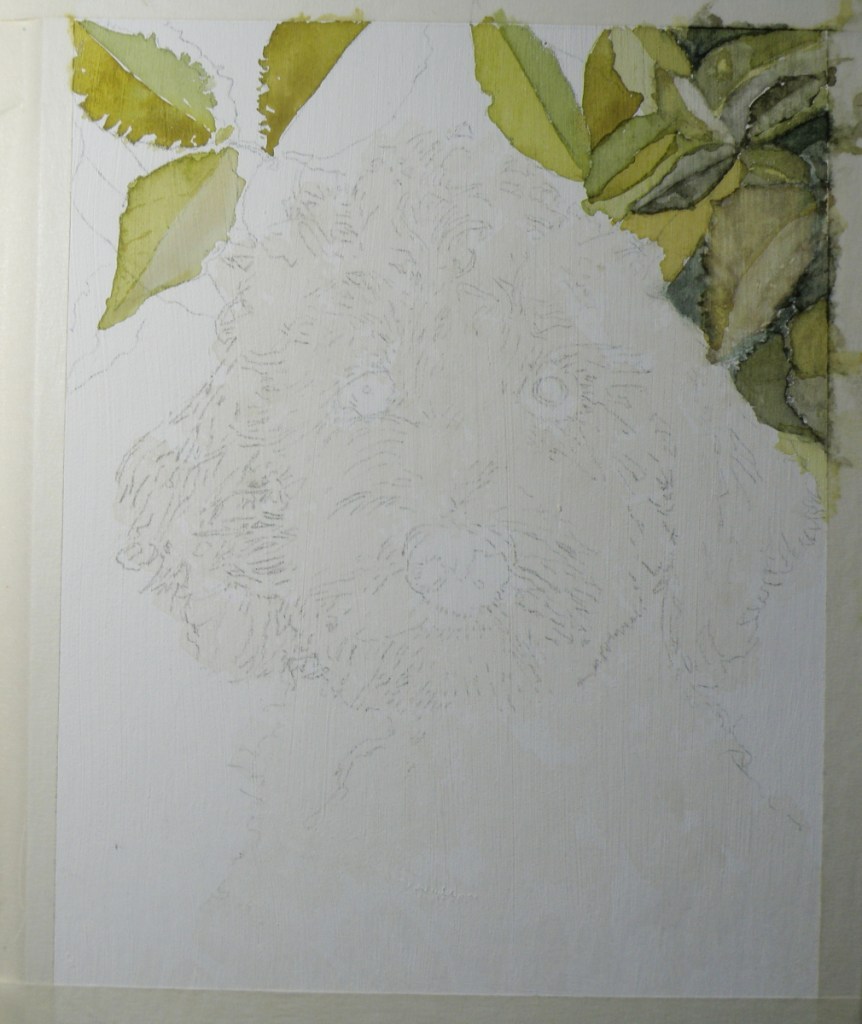Victorian Pop-up Christmas Card #2
December 19, 2021
This second Dickens-like Christmas pop-up card was sent to friends whose Labradoodle dog, ‘Juno’, was the subject of a portrait found in the post for March 9th. . .
…..and its pop-up figures inside serenade the viewer with carols while ‘Juno’ wishes she were inside next to a warm fireplace :
Painting Progression 4: Juno, finished
March 9, 2021
While painting this portrait of Juno in honour of Kathie’s birthday, our little Bichon, ‘Elmo’, was in the final days of his thirteen-year-old life. Stoically dealing with a heart twice its normal size, an enlarged liver and kidney malfunction, our beloved ‘Elmo’ passed away in his bed just after I’d checked on him on January 24th. For his two daddies, this was a sorrowful occasion and one very difficult to get over.
As the weeks passed, however, we realised we needed to at least try to fill the emotional hole of losing our lovely pet and began searching far and wide for a new puppy. At the same time, I was close to finishing the portrait of Juno and finally did, a couple of weeks before Kathie’s big day:
Kathie and Ken were very pleased and the Juno portrait now hangs in their dining room.
And we–Raul and I–have a new addition to our family, a tiny toy Maltipoo puppy named ‘Ashton’, who can never replace ‘Elmo’ and yet has won us completely over by his beautiful perky cuteness and charming personality:
Painting Progression 3 ‘Juno’
March 7, 2021
“Juno was the sister and wife (hmmm) of Jupiter, and the mother of Mars and Vulcan. The patron goddess of Rome and protector of women and marriage, Juno’s name is heard in Virgil’s Aeneid, Shakespeare’s The Tempest, and Sean O’Casey’s 1924 play Juno and the Paycock.” [source: https://nameberry.com/babyname/Juno%5D
Although I’m posting these progressive treatments over a few days, this painting actually took me several weeks. That’s because I just wasn’t sure how to go about it. Painting complicated hair/fur isn’t my forte. And watercolour isn’t a terribly forgiving medium. So I ultimately chose to use Daniel Smith’s Watercolour Ground applied over white art board. The lovely quality of this product is how easily one can lift mistakes off it–it lifts previously applied, and dried paint, like a dream. What it therefore doesn’t allow is a number of washes or glazes on top of each other, because once a fresh wash is placed over a dried wash, that old one will lift and mix with the new wet one. So my experience has been to use one put-down of wash and let that be the one, and if it doesn’t look good, just put water all over it and lift it right off and wait till the surface has dried and start again.
Painting Progression 2: Juno
March 6, 2021
Because Labradoodles are created by mating a Labrador with a Poodle, any number of colour combinations are possible, including black, dark brown, reddish brown, blonde-brown and who knows how many others. Each puppy can be more like the father, or take after the mother, with different fur/hair qualities as a result. Juno’s hair is a delicious golden colour and not as tightly curled as a Poodle, but not as straight as a Labrador, and so very curly and yet wavy.
Here is the way the painting progressed from the initial sketch and wash:
Personally, I have a need to establish the eyes and nose before progressing further. If they don’t happen correctly, forget about it. I was satisfied that my attempts looked true enough to the image I was given to work from to keep on working.
Painting Progression: Juno
March 5, 2021
To help celebrate the birthday of a recently retired Occupational Therapist and good friend–Kathie–her spouse, Ken, the Dean of our local Anglican Cathedral, provided me with photographs of their very charming one year old Labradoodle dog, Juno. My hope was to present Kathie with a watercolour portrait of Juno to mark her upcoming, significant ‘0’ birthday,
Dog portraiture is not something I have experience with/in. And Juno being from a breed known for its gorgeous curls and wavy hair/fur, presented challenges I wasn’t convinced my experience with watercolour could overcome. Fortunately, this painting was one I offered to do, and so if it was beyond my abilities I simply had to say so and produce a watercolour of another subject I knew Kathie would enjoy receiving.
I started with a detailed drawing:
Because Juno’s place to be is anywhere outdoors, I decided to provide a rosebush background.
When one reads about the long life of Jean Sibelius and how he had such a strong affinity for nature, for Autumn and Winter in particular, and was, after all, a Finn, whose country embraces the colder months, it seemed fitting to depict Sibelius Square in November. His biographer wrote this:
“. . . Even by Nordic standards, Sibelius responded with exceptional intensity to the moods of nature and the changes in the seasons: he scanned the skies with his binoculars for the geese flying over the lake ice, listened to the screech of the cranes, and heard the cries of the curlew echo over the marshy grounds just below Ainola [his home, named after his wife]. He savoured the spring blossoms every bit as much as he did autumnal scents and colours. . . “
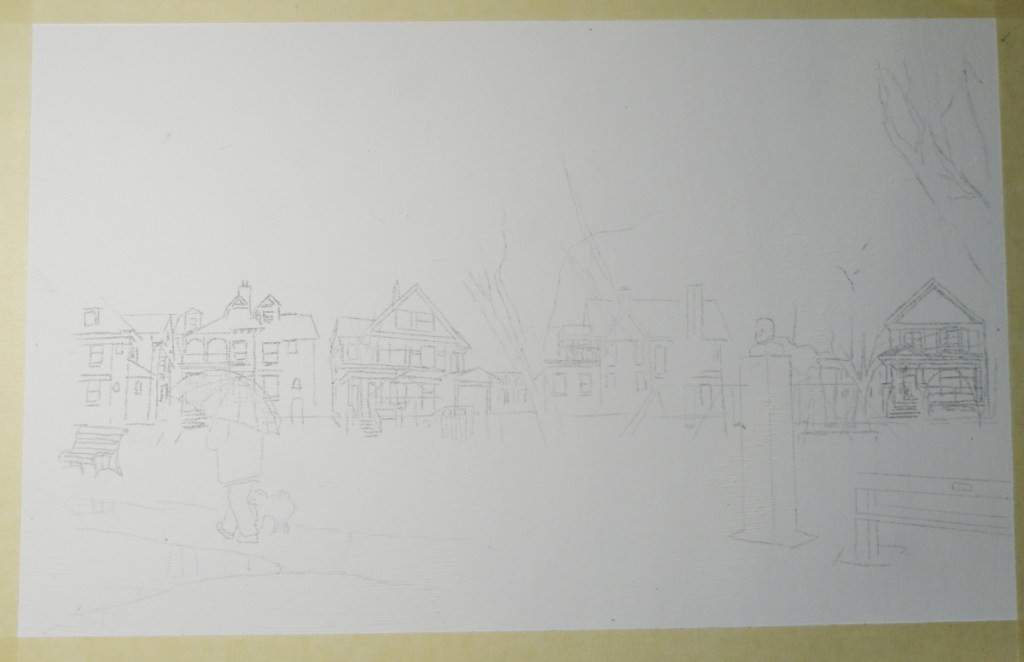
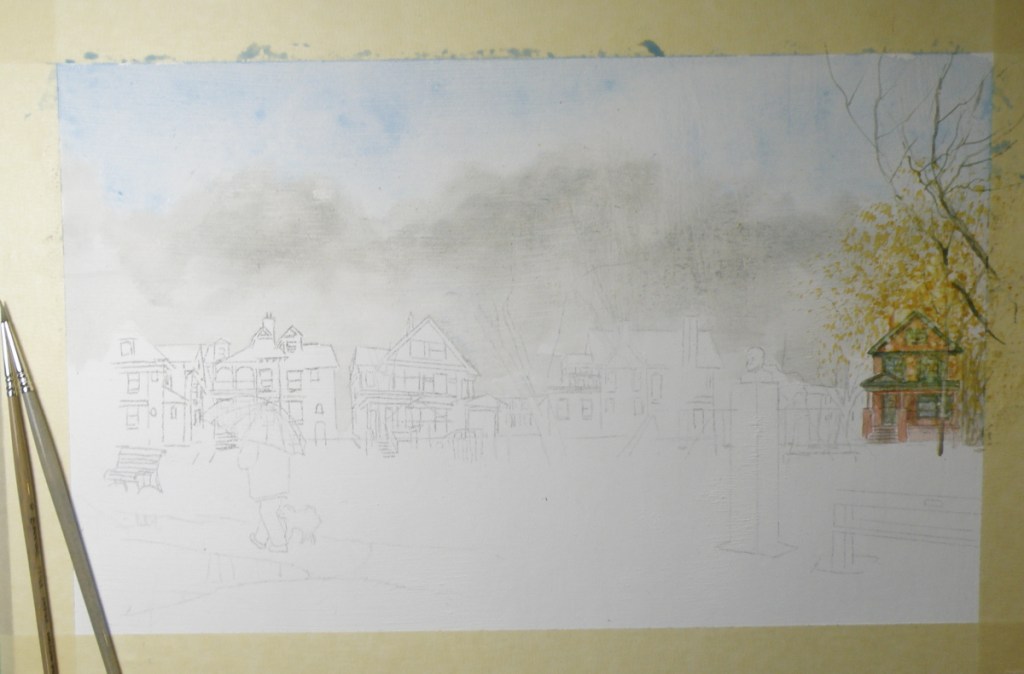

The distinctive, late 19th c. Toronto architecture of the area known as The Annex is unabashedly Victorian, boasting ‘some of the largest collection of Victorian houses in North America.’
‘During this period Toronto also developed some unique styles of housing. The bay-and-gable house was a simple and cost effective design that also aped the elegance of Victorian mansions. Built of the abundant red brick, the design was also well suited to the narrow lots of Toronto.’ [wikipedia: The Architecture of Toronto]
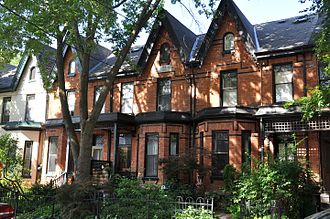
In The Annex, however, there was an elegance reserved only for those who could afford it. ‘Built by the city’s wealthy and mostly found in the neighbourhood they are named after, these houses contain diverse and eclectic elements borrowed from dozens of different styles. These houses are built of a mix of brick and sandstone, turrets, domes, and other ornamentation abound.’ [ibid.]

In this painting, some decisions had to be made as to whether it was going to be about the houses surrounding The Jean Sibelius Square Park, or about the monument dedicated to the composer, or about the overall mood of late Autumn and how it informs the architecture, the park and what Sibelius himself loved about November.
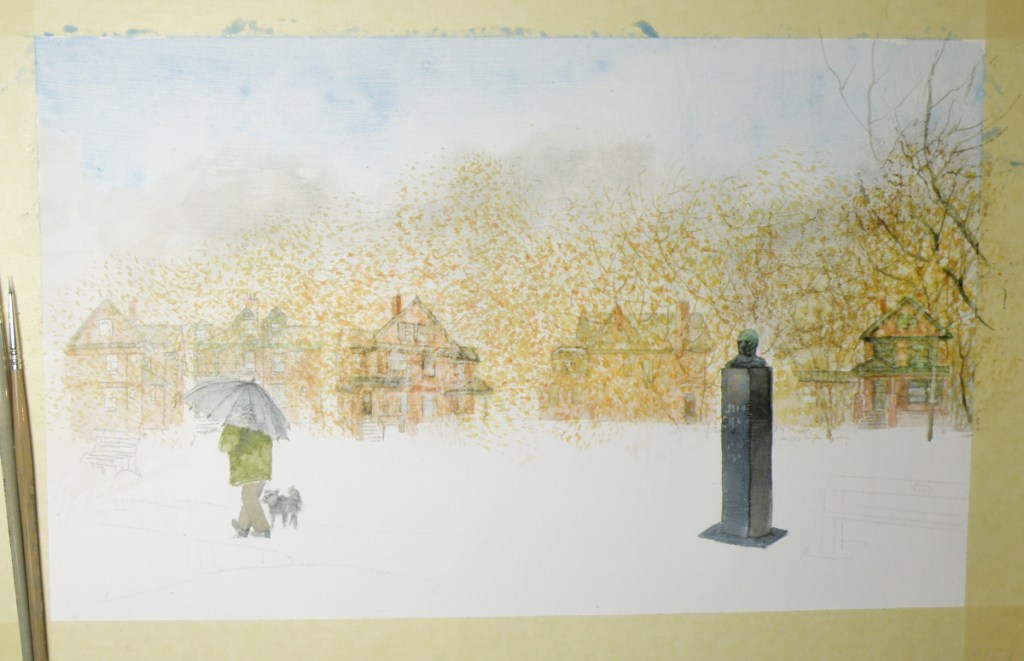
This neighbourhood-emersed, one square acre oasis in the middle of Toronto [pop. 6,129,000], was originally known as Kendal Square due to being beside Kendal Avenue…
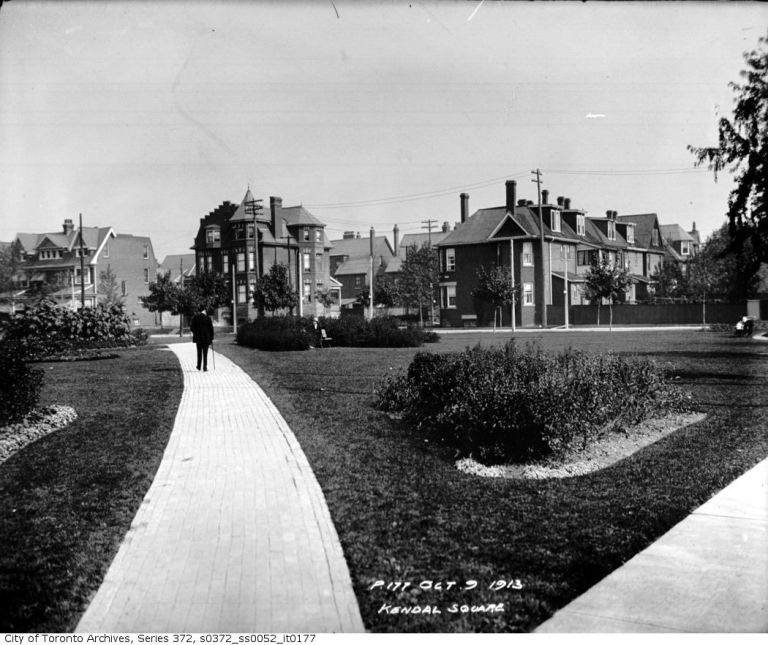
In 1959, in recognition of the diligence and passion of Toronto’s Finnish community, the little square was officially renamed Jean Sibelius Square and featured a striking monument with the Finish composer’s likeness crowning it.
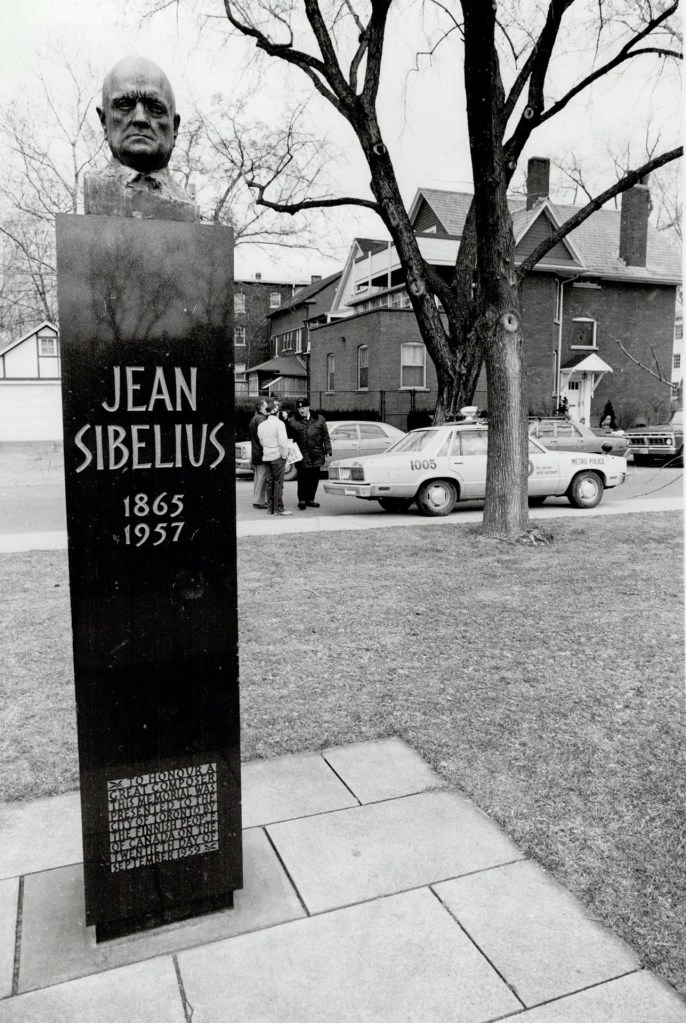
My encounter with this petite and charming park was during the socially-disruptive 70s, when The Annex was transformed from a neighbourhood of red-brick mansion propriety, to one of red-brick mansion rooming houses populated by hippies and university students.
I lived in the former red brick Victorian home of a Toronto physician with fifteen other actors–including Doug Todd, who has commissioned this painting of Jean Sibelius Square. We were members of the theatre ensemble called Creation 2 (I for seven years, he for two), which was both commune and theatre ensemble:
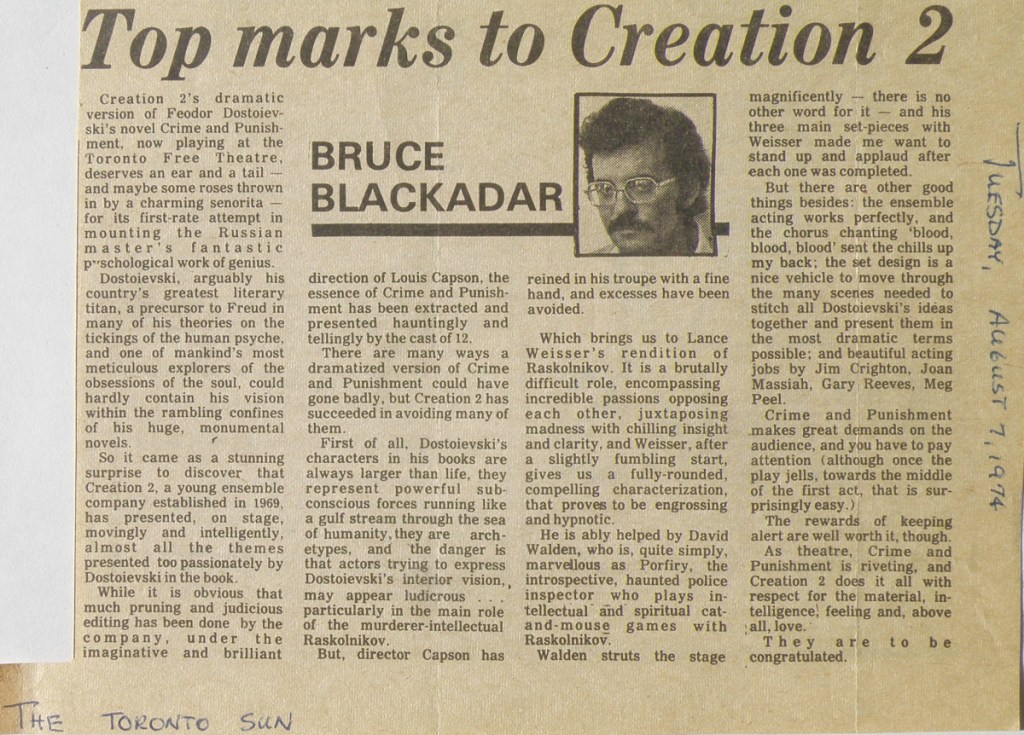
Life for Doug Todd and I, and others within the group, was a mixture of great bonding, high demands, internal turmoil and personal confusion. What had started out as a dynamic experiment combining the best of ensemble acting with the ideals of a close-knit communal living, began taking on the telling characteristics of a cult.
The Jean Sibelius Square Park, being a block away from our living situation, provided us with a treed, quiet, people-free place of calm and restoration. The watercolour depicting that 1970s’ oasis-like feeling is now finding its expression as it goes from outlined sketch to the initial wash stage:



